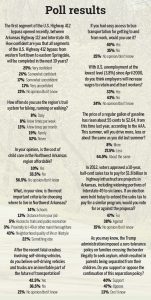Poll: NWA residents explore bike trails, buses, highways and taxes
by July 12, 2018 4:09 pm 961 views

Two wheels, four wheels, six wheels or 18 wheels — travel and trade in Northwest Arkansas centers on a variety of business and personal preferences and the attitudes are as diverse as the options in the region.
A new Northwest Arkansas Business Journal poll, conducted June 24-26 by Talk Business & Politics, Hendrix College and Impact Management Group among 400 Benton and Washington county residents, explored concerns about road construction, bike trails, public transportation, highway taxes and more.
Six months ago, “roads and infrastructure” were identified as the top issue impacting the region by a nearly two-to-one margin over healthcare, education, taxes and jobs. In the latest survey, either a majority or plurality of residents indicated:
• They would pay taxes to continue highway projects;
• They support widening Interstate 49 to six lanes;
• They don’t utilize the growing trails system in NWA; and
• They would take a bus to work.
“Many of the questions in our survey touched on transportation in some manner. It’s appropriate because of the role of that issue in shaping the life of the region,” said Dr. Jay Barth, professor of political science at Hendrix College, who helped construct and analyze the poll.
“Respondents in our sample, despite the general political conservatism of the residents of the region, are more than happy to continue investment in roads. A near majority (47%) of them would support a sales tax extension to further expand I-49, the major artery through the major cities of the region,” Barth said.
NWA residents were specifically asked about the recently opened U.S. Highway 412 bypass between Arkansas Highway 112 and I-49. When asked how confident they were all segments of the bypass from western Tontitown to eastern Springdale would be completed in the next decade, 51% said they were “very or somewhat confident.”

BIKE TRAILS AND BUSES
Investments in the region’s trails system — a quality of life feature aimed at meeting the desires for Millennials and families — are currently underutilized, according to the survey.
About 29% use the trails system anywhere from daily to a few times per month, while 19% rarely use it and 52% say they never use the pathway for biking, running or walking. This could be a baseline question for future polling of residents to see if the relatively new and constantly developing corridor connecting the four major cities of NWA grows in usage over time. It also doesn’t mean the system isn’t appreciated.
Barth observed that younger poll respondents who use the trails system daily was in double-digits, and Coon noted the millions of dollars invested in the system is paying dividends in downtown revitalization and economic development projects aimed at diversifying work and recreation options.
Another question in the survey folding into this attitude centers on the most important criteria of where to live in Northwest Arkansas. “Neighborhood quality of life or lifestyle” was the overwhelming pick with 43%, followed by “something else” at 22% and options such as schools (14%) or distance from job (13%) further down the list.
“In decisions about housing, there tends to be a focus on issues like access to good transportation, schools or recreational opportunities. It is those issues on which real estate agents focus,” Barth said. “But for residents of Northwest Arkansas, such decisions are driven by what such housing decisions denote about the lifestyle available in that setting. Small percentages of our respondents focused on schools and transportation, but nearly two-thirds focus on ‘neighborhood quality of life or lifestyle’ or ‘something else’ in responding to the question about the criteria that drive choices about where they live.”
“This factor was consistently the top choice across all demographic breakdowns including gender, age, race and education,” Coon said.
Bus transportation was also surveyed, and there is healthy support for the transit system in the region, particularly among younger residents. Forty percent (40%) said if they had easy access to bus transportation for getting to and from work, they would use it. Thirty-five percent (35%) said they would not and 25% had no opinion. Coon said the demographics of the question offered much insight for planners to understand who their current and potential target audience would be for public transportation.
“Older voters, 65 and over, were less likely to indicate a willingness to use bus transportation at only 28.7%. [But] 66.7% of black voters surveyed said they would utilize bus transportation, while white voters were evenly split. Notably, male voters rejected the use of bus transportation (43.9%) much more so than female voters (31.0%),” he said.
“Such openness to a diversity of transportation options is particularly prevalent among the youngest respondents in the survey,” Barth said. “A healthy majority of those under 45 believe that self-driving cars are part of our transportation future, the percentage of that age group that uses the region’s trail system at least daily is in double-digits, and a near majority of that age group would use bus travel to get to work daily if it were available.”
